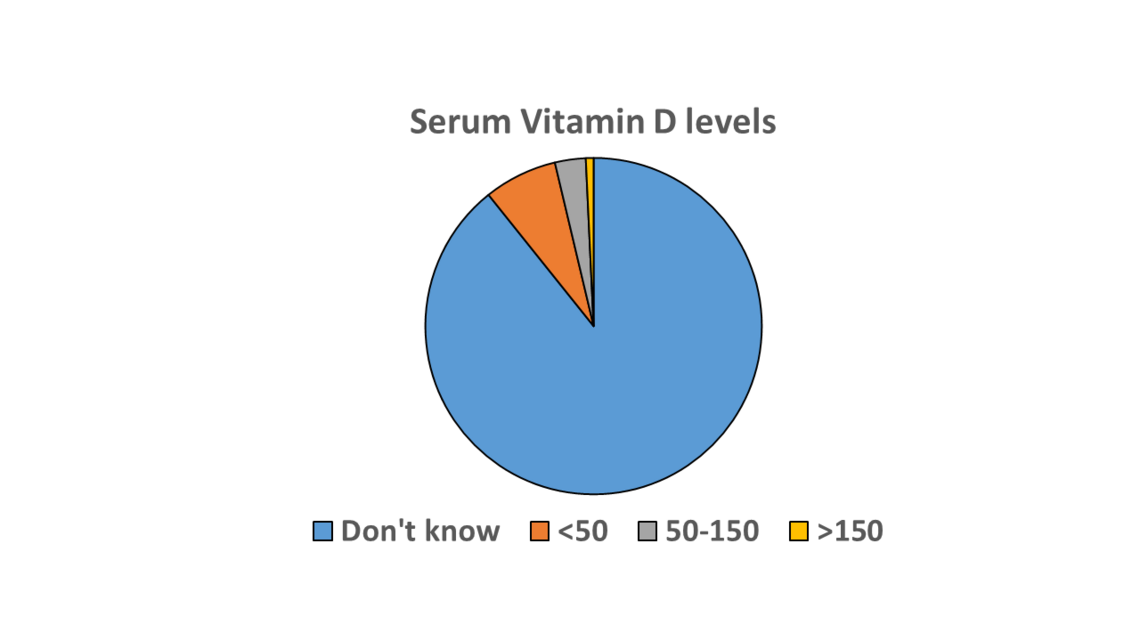Most people surveyed didn’t know their Vitamin D level. Of those who did, nearly two thirds had Vitamin deficiency.
These are two key findings from our survey.
Why we undertook the reseach
First, Vitamin D is important for health:
- It is important (with calcium) for strong bones and teeth. Deficiency in children can lead to rickets – and in the elderly to increased risk of osteoporosis and hip fracture.
- It helps strengthen our immune system - for example by helping protect against respiratory disease.
- Lack of Vitamin D has been associated with an increased risk of cardiovascular disease (heart attack and stroke), cancer and diabetes – although it isn’t yet clear whether the Vitamin D deficiency is actually contributing to the increased risk.
Second, the main natural source of Vitamin D is the sun. However, limited sunshine in the UK, more time spent indoors, skin cancer scares and the increasing addition of sun screen to make up have combined to increase the risk of Vitamin D deficiency.
So we aimed to research public awareness of Vitamin D and how people were responding to the sun.
Here’s what we found:
- 90% of people surveyed didn’t know their Vitamin D level.
- Of those who did know their level, 65% had been found to be Vitamin D deficient.
- 38% of those surveyed consciously avoided the sun (the main natural source of Vitamin D) or put on sun screen, from sun cream or make up, before going out of the house.
- Women were much more likely to know their Vitamin D level than men.
- Participants from ethnic minority backgrounds were more likely to know their level. This reflected the fact that people with darker skin are one group at greater risk of Vitamin D deficiency when living in countries like the UK, where the sun is limited. A number of ethnic minority participants mentioned that a relative had been found to have a Vitamin D deficiency and that this had triggered them to arrange a blood test with their GP.
- A number of white participants or their family members had also been found to be Vitamin D deficient. Possible factors suggested for women were always wearing make-up containing anti-ageing sun screen when going out of the house; and for men spending too much time indoors (at the office at work and then in front of the computer when they get home). This meant they were getting very little access to Vitamin D from the sun.
270 people took part in our pilot survey, either online or in person, between September 2013 and April 2014. The table below shows their age range, gender and ethnicity.
|
|
Gender |
Ethnicity |
Age |
||||
|
|
M |
F |
White |
Other |
Under 40 |
40-59 |
60+ |
|
270 |
119 |
151 |
232 |
38 |
122 |
123 |
25 |
|
% |
44% |
56% |
86% |
14% |
45% |
45% |
< 10% |
Comments from survey participants suggested:
Some people were unaware of the potential health benefits of Vitamin D (like helping boost the immune system and, with calcium, strengthening bones).
However, there seemed to be growing awareness of the potential health benefits. Some concern was expressed about the current trend to cover young children with sun cream before they go to school and similar action by schools to keep young children covered up. Current health advice is to spend around 10 minutes in the sun if your skin is fair and up to 15 minutes if it is dark – and then add sun screen.
The main reasons people gave for avoiding the sun were:
- To avoid the risk of skin cancer, in the light of medical advice to slap on sun cream and cover up.
- Their skin burns quickly, they had been badly sunburnt when younger or they had a relative with skin cancer.
- Appearance (either to avoid ageing the skin or, in the case of some South Asian women, to avoid darkening the skin).
COMMENTARY
The results from our pilot survey suggest:
- Most people didn’t know their Vitamin D level (see below).
- Awareness of the value of Vitamin D and of the sun as the main source of Vitamin D is growing – but many people are still unaware of this or not acting on what they know.
- Awareness is greater among ethnic minority communities but is still limited and tends to be triggered when a family member is found to have a low level of Vitamin D.
- Make up with anti-ageing sun screen may lead to an increase in Vitamin D deficiency among women over the longer term, while the desire for a lighter skin may increase the existing risk for some South Asian women in the UK.
- An indoor lifestyle (for both work and leisure) is another possible risk factor.
Vitamin D levels are measured using a chemical unit called nanomoles (nmol) per litre (L).
It is generally agreed that:
- Less than 25 nmol/L is deficient
- 25 – 50 nmol/L is insufficient or inadequate
- 50 – 75 nmol/L is adequate or normal
Some researchers believe that a level of more than 75 nmol/L is optimal.
However, too much Vitamin D can also be harmful. In the US it has been suggested that a level above 125 nmol/l can have potential adverse effects.

